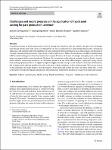Item Infomation
Full metadata record
| DC Field | Value | Language |
|---|---|---|
| dc.contributor.author | Samson Dare, Oguntuyi | - |
| dc.contributor.author | Kasongo, Nyembwe | - |
| dc.contributor.author | Mxolisi Brendon, Shongwe | - |
| dc.date.accessioned | 2023-04-18T01:41:54Z | - |
| dc.date.available | 2023-04-18T01:41:54Z | - |
| dc.date.issued | 2023 | - |
| dc.identifier.uri | https://link.springer.com/article/10.1007/s00170-023-11049-1 | - |
| dc.identifier.uri | https://dlib.phenikaa-uni.edu.vn/handle/PNK/8014 | - |
| dc.description | CC BY | vi |
| dc.description.abstract | Conventional means of producing material via metal casting have long been used for centuries. In spite of its advantages in producing durable parts with lower cost implications and the accommodation of large part production, this conventional approach is still characterized by the challenges of high lead time in patterns production, poor surface finish, and the need for secondary manufacturing operations, which always leads to material loss. Hence, the introduction of additive manufacturing (AM) to metal casting process has been immensely recognized because of its huge advantages in negating some of the challenges encountered in the conventional route. However, the inconsistency in the material properties (such as density, strength, elastic modulus, dimensional accuracies, surface finish), produced by one of the AM techniques (rapid sand casting), has not been yielding optimum results to be applied in high-tech application like aerospace and automotive industries. | vi |
| dc.language.iso | en | vi |
| dc.publisher | Springer | vi |
| dc.subject | application of rapid sand casting | vi |
| dc.title | Challenges and recent progress on the application of rapid sand casting for part production: a review | vi |
| dc.type | Book | vi |
| Appears in Collections | ||
| OER - Kỹ thuật điện; Điện tử - Viễn thông | ||
Files in This Item:

